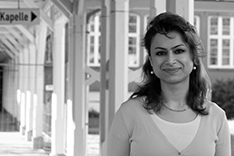Biomechanics

Dr. Forough Madehkhaksar - Biomedical Engineer
Network Aging Research
Bergheimer Straße 20
D-69115 Heidelberg
Phone: +49 (0)6221 54 81 32
madehkhaksar(at)nar.uni-heidelberg.de
Fellow: Dr. Michael Schwenk
Investigating balance and fall risk following an unexpected perturbation in older adults
Falls are an important clinical problem and a major cause of functional limitations and disabilities among older adults (Schwenk, Lauenroth et al. 2012). Falls are a consequense of a postural control failure in maintaining balance which often occurs following an unexpected perturbation. An unexpected perturbation often happens due to a mechanical perturbation such as trip, slip, and missteps (Maki, Cheng et al. 2008), or due to changes in the sensory environment (sensory perturbation) (Terry, Sinitski et al. 2012). Age-associated impairments in the postural system, biomechanical constraints (reduced joint range of motion), muscle weakness, and delay central processing may reduce the capability of older adults to compensate for unexpected perturbations.
Factors that cause failure in postural control in older adults are still poorly understood. Therfore, understanding how elderly people maintain and control stability when being exposed to perturbations might be a key to preventing falls and predicting the likelihood of falling. For this aim, experimental/computational approaches can be used to better understand the control of posture in perturbation situations which disrupt balance and by recording/simulation of postural responses of these perturbations (McAndrew, Wilken et al. 2011; Süptitz, Karamanidis et al. 2012; Francis, Franz et al. 2015).
This thesis investigates the control of posture in older adults in response of a sudden perturbation which is a sudden change in postural equilibrium conditions. These perturbations consist of mechanical perturbation (such as treadmill perturbation which is similar to a trip or slip) as well as sensory perturbations (such as vestibular, visual, and somatosensory perturbation). This research helps to obtain a better insight into specific control systems and strategies that are responsible for maintaining balance in such situations. By taking into account that balance is a skill that nervous system learns to accomplish using the interaction of multiple systems which can adapt with training and experience, this study can also potentially help to develop new exercise programs and therapeutic interventions including sensory, motor, and cognitive components.
References
- Francis, C. A., J. R. Franz, et al. (2015). "Gait variability in healthy old adults is more affected by a visual perturbation than by a cognitive or narrow step placement demand." Gait & posture 42(3): 380-385.
- Maki, B. E., K. C.-C. Cheng, et al. (2008). "Preventing falls in older adults: new interventions to promote more effective change-in-support balance reactions." Journal of electromyography and kinesiology 18(2): 243-254.
- McAndrew, P. M., J. M. Wilken, et al. (2011). "Dynamic stability of human walking in visually and mechanically destabilizing environments." Journal of biomechanics 44(4): 644-649.
- Schwenk, M., A. Lauenroth, et al. (2012). "Definitions and methods of measuring and reporting on injurious falls in randomised controlled fall prevention trials: a systematic review." BMC medical research methodology 12(1): 1.
- Süptitz, F., K. Karamanidis, et al. (2012). "Symmetry and reproducibility of the components of dynamic stability in young adults at different walking velocities on the treadmill." Journal of electromyography and kinesiology 22(2): 301-307.
- Terry, K., E. H. Sinitski, et al. (2012). "Amplitude effects of medio-lateral mechanical and visual perturbations on gait." Journal of biomechanics 45(11): 1979-1986.
Journals
- Madehkhaksar, F. and A. Egges (2016). "Effect of dual task type on gait and dynamic stability during stair negotiation at different inclinations." Gait & posture 43: 114-119.
Book chapters
- Ali Akhras, M, Bortoletto, Roberto, Madehkhaksar, F. & Tagliapietra, Luca (31.10.2015). Neural and Musculoskeletal Modeling - Its Role in Neurorehabilitation. In José L. Pons, Rafael Raya & José González (Eds.), Emerging Therapies in Neurorehabilitation II (pp. 109-143). Switzerland: Springer.
- Madehkhaksar, F., Luo, Z., Pronost, N. & Egges, A. (2014). Modeling and Simulating Virtual Anatomical Humans. In Nadia Magnenat-Thalmann, Osman Ratib & Hon Fai Choi (Eds.), 3D MultiScale Physiological Human Springer.
International conferences
- Madehkhaksar F., Egges A., “Gait speed and postural stability during stair negotiation: effects of dual task and postural task difficulty”, 21st Congress of the European Society of Biomechanics, Oral presentation, Prague, Czech Republic, July 2015.
- Forough Madeh Khaksar, Mehran Kasra, Nicolas Pronost, “Effect of Abdominal Muscles Elongation During Pregnancy on L4-L5 Spinal Load Using a Finite Element Model”, 8th combined meeting of orthopaedic research societies, poster presentation, San Servolo Venice, Italy, October 2013.
- Mehran Kasra, Forough Madehkhaksar, Masoud Ramezanzadehkoldeh, “Effect of Psoas Muscle Spasm in L4-L5 Spinal Load: A Finite Element Study Simulating Active Response of Skeletal Muscle in Low Back Pain”, 59th Annual Meeting of the Orthopaedic Research Society, poster presentation, Texas, USA, January 2013.
- B. Heidari, F.M. Khaksar, D. FitzPatrik, “Development of Three-dimensional Model of Spine, Using Bi-planar Radiographic Images and Adaptation of Prior CT Data”, 6TH world congress of biomechanics-WCB 2010, IFMBE Proceedings 31, pp. 1550–1553, Singapore, August 2010.
- Behnam Heidari, Forough Madehkhaksar, David FitzPatrick, “Towards Automated 3-D Scoliotic Spine Reconstruction by Using Biplanar Radiographic Images and Statistical Models”, 16th Biannual Conference of The Canadian Society for Biomechanics – CSB 2010 SCB, pp. 130 , Ontario, Canada, June 2010.
- B. Heidari, F. Madehkhaksar, D. FitzPatrik, “Automatic Landmark Detection on Epicondyles of Distal Femur in X-Ray Images”, 4th European Conference of the International Federation for Medical and Biological Engineering-ECIFMBE 2008, IFMBE Proceedings 22, pp. 533–536, Belgium, 2008.
Vita
| since 04/2016 | PhD Candidate, Network Aging Research, Heidelberg, Germany | |
| 04/2013 - 12/2015 | Researcher, Virtual worlds research group, Department of Information and Computing Sciences, Utrecht University Netherlands | |
| 10/2011 - 04/2013 | Researcher, Faculty of Biomedical Engineering at Amirkabir University, Iran | |
| 2009 - 2011 | Master of Science, Biomedical engineering (Biomechanics), Amirkabir University of Technology (Tehran Polytechnic), Tehran, Iran | |
| 2004 - 2008 | Bachelor of Science, Biomedical engineering (Biomechanics), Azad University (Science and Research Branch), Tehran, Iran |


